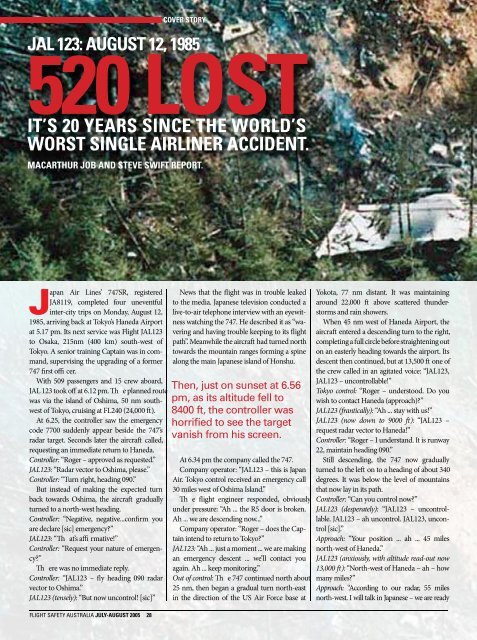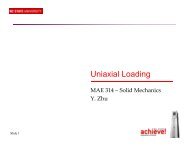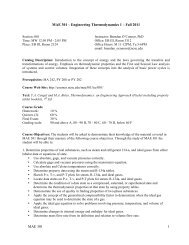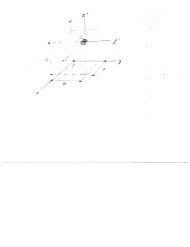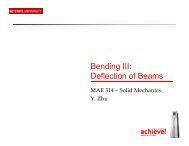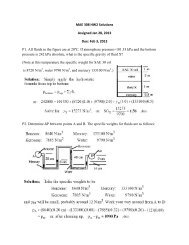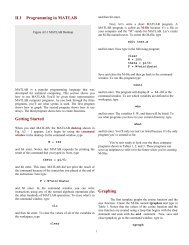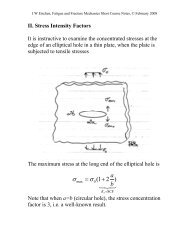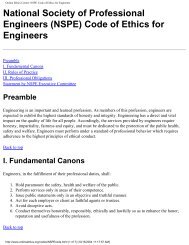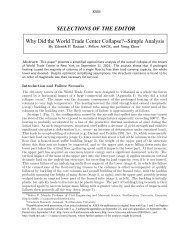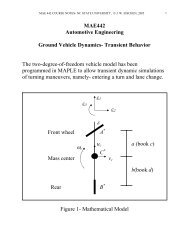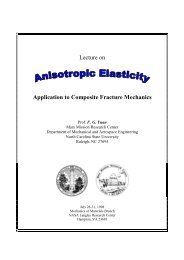Flight Safety Australia - July-August 2005 pg28-33 - Civil Aviation ...
Flight Safety Australia - July-August 2005 pg28-33 - Civil Aviation ...
Flight Safety Australia - July-August 2005 pg28-33 - Civil Aviation ...
Create successful ePaper yourself
Turn your PDF publications into a flip-book with our unique Google optimized e-Paper software.
COVER STORY<br />
JAL 123: AUGUST 12, 1985<br />
520 LOST<br />
IT’S 20 YEARS SINCE THE WORLD’S<br />
WORST SINGLE AIRLINER ACCIDENT.<br />
MACARTHUR JOB AND STEVE SWIFT REPORT.<br />
Japan Air Lines’ 747SR, registered<br />
JA8119, completed four uneventful<br />
inter-city trips on Monday, <strong>August</strong> 12,<br />
1985, arriving back at Tokyo’s Haneda Airport<br />
at 5.17 pm. Its next service was <strong>Flight</strong> JAL123<br />
to Osaka, 215nm (400 km) south-west of<br />
Tokyo. A senior training Captain was in command,<br />
supervising the upgrading of a former<br />
747 first offi cer.<br />
With 509 passengers and 15 crew aboard,<br />
JAL 123 took off at 6.12 pm. Th e planned route<br />
was via the island of Oshima, 50 nm southwest<br />
of Tokyo, cruising at FL240 (24,000 ft).<br />
At 6.25, the controller saw the emergency<br />
code 7700 suddenly appear beside the 747’s<br />
radar target. Seconds later the aircraft called,<br />
requesting an immediate return to Haneda.<br />
Controller: “Roger – approved as requested.”<br />
JAL123: “Radar vector to Oshima, please.”<br />
Controller: “Turn right, heading 090.”<br />
But instead of making the expected turn<br />
back towards Oshima, the aircraft gradually<br />
turned to a north-west heading.<br />
Controller: “Negative, negative...confirm you<br />
are declare [sic] emergency?”<br />
JAL123: “Th at’s affi rmative!”<br />
Controller: “Request your nature of emergency?”<br />
Th ere was no immediate reply.<br />
Controller: “JAL123 – fly heading 090 radar<br />
vector to Oshima.”<br />
JAL123 (tensely): “But now uncontrol! [sic]”<br />
FLIGHT SAFETY AUSTRALIA JULY-AUGUST <strong>2005</strong> 28<br />
News that the flight was in trouble leaked<br />
to the media. Japanese television conducted a<br />
live-to-air telephone interview with an eyewitness<br />
watching the 747. He described it as “wavering<br />
and having trouble keeping to its flight<br />
path”. Meanwhile the aircraft had turned north<br />
towards the mountain ranges forming a spine<br />
along the main Japanese island of Honshu.<br />
Then, just on sunset at 6.56<br />
pm, as its altitude fell to<br />
8400 ft, the controller was<br />
horrified to see the target<br />
vanish from his screen.<br />
At 6.34 pm the company called the 747.<br />
Company operator: “JAL123 – this is Japan<br />
Air. Tokyo control received an emergency call<br />
30 miles west of Oshima Island.”<br />
Th e flight engineer responded, obviously<br />
under pressure: “Ah ... the R5 door is broken.<br />
Ah ... we are descending now...”<br />
Company operator: “Roger – does the Captain<br />
intend to return to Tokyo?”<br />
JAL123: “Ah ... just a moment ... we are making<br />
an emergency descent ... we’ll contact you<br />
again. Ah ... keep monitoring.”<br />
Out of control: Th e 747 continued north about<br />
25 nm, then began a gradual turn north-east<br />
in the direction of the US Air Force base at<br />
Yokota, 77 nm distant. It was maintaining<br />
around 22,000 ft above scattered thunderstorms<br />
and rain showers.<br />
When 45 nm west of Haneda Airport, the<br />
aircraft entered a descending turn to the right,<br />
completing a full circle before straightening out<br />
on an easterly heading towards the airport. Its<br />
descent then continued, but at 13,500 ft one of<br />
the crew called in an agitated voice: “JAL123,<br />
JAL123 – uncontrollable!”<br />
Tokyo control: “Roger – understood. Do you<br />
wish to contact Haneda (approach)?”<br />
JAL123 (frantically): “Ah ... stay with us!”<br />
JAL123 (now down to 9000 ft): “JAL123 –<br />
request radar vector to Haneda!”<br />
Controller: “Roger – I understand. It is runway<br />
22, maintain heading 090.”<br />
Still descending, the 747 now gradually<br />
turned to the left on to a heading of about 340<br />
degrees. It was below the level of mountains<br />
that now lay in its path.<br />
Controller: “Can you control now?”<br />
JAL123 (desperately): “JAL123 – uncontrollable.<br />
JAL123 – ah uncontrol. JAL123, uncontrol<br />
[sic].”<br />
Approach: “Your position ... ah ... 45 miles<br />
north-west of Haneda.”<br />
JAL123 (anxiously, with altitude read-out now<br />
13,000 ft): “North-west of Haneda – ah – how<br />
many miles?”<br />
Approach: “According to our radar, 55 miles<br />
north-west. I will talk in Japanese – we are ready
COVER STORY<br />
Photo:AAP<br />
photo: newsweek<br />
for your approach anytime. Also Yokota landing<br />
Sprawling (above): The wreakage of Japan<br />
is available – let us know your intentions.”<br />
Airlines <strong>Flight</strong> 123 on the slopes of Mount<br />
Th ere was no reply. Th e 747’s height was<br />
Osutaka. Clearly visible is part of a wing.<br />
Aftermath (inset right): Rescue workers<br />
now decreasing again and, by 6.54 pm, its<br />
with debris from the accident.<br />
altitude read-out was 11,000 ft. Approach<br />
called the aircraft again, advising its position<br />
was “50 miles – correction 60 miles”<br />
to recover its balance to the right. It was<br />
north-west of Haneda Airport. But again<br />
flying just like a staggering drunk.”<br />
there was no response.<br />
Because of the inaccessibility of the area, it<br />
A minute later, its target suddenly devi-<br />
was not until 9 am, more than 14 hours after<br />
ated 90° to the right and, as its altitude read-<br />
the crash, that civil defence workers reached<br />
out rapidly decreased, it entered a tight turn<br />
the site. Fog had forced a temporary suspen-<br />
of less than 2 nm radius. Th en, just on sunset<br />
sion of mountain flying, but when conditions<br />
at 6.56 pm, the controller was horrified to<br />
improved, army paratroopers arrived aboard<br />
see the target vanish from his screen.<br />
Chinook helicopters, rappelling down to<br />
Further calls to the 747 went unanswered.<br />
where the wreckage lay.<br />
Moments later, a military jet reported “a huge<br />
Th e disaster was now revealed. Flying a<br />
burst of flame in the Nagano Mountains”.<br />
westerly heading, the Boeing 747 had de-<br />
Impact in the mountains: It was dark by<br />
scended into a pine forest near the top of the<br />
the time two search helicopters reached the<br />
northern face of the 5400 ft Mt Osutaka, a<br />
area through showery weather. Attracted by<br />
narrow, steep-sided east-west ridge, explod-<br />
a fire blazing near the top of the 5400 ft Mt<br />
ing into flames and breaking up as it bounced<br />
Osutaka in inaccessible ranges more than<br />
along the ridge line.<br />
60 nm north-west of Tokyo, one helicopter<br />
Th ere was no sign of survivors. In Tokyo,<br />
pinpointed the site of the crash, reporting<br />
the fearful news was confirmed to waiting<br />
flames “over an area about 300 m square”.<br />
media – the highest death toll ever in a single-<br />
One witness, surprised at seeing an airaircraft<br />
accident.<br />
liner above his remote mountain village,<br />
Well down the mountain face, a fireman<br />
described its erratic flight. “All of a sudden,<br />
stood on the steep slope surveying the wreck-<br />
a big aeroplane appeared from between<br />
age. Suddenly he saw something that looked<br />
mountains,” he told police. “Four times<br />
like an arm waving! Sure enough, a young<br />
it leaned to the left, and each time it tried<br />
woman, conscious though suffering a broken<br />
Photo:AAP<br />
AAP<br />
pelvis and a fractured arm, was pinned between<br />
two sets of seats.<br />
Not long afterwards there was more good<br />
news – a 12-year-old schoolgirl was found<br />
wedged in a tree, suffering nothing more serious<br />
than cuts and bruises. Even more was to<br />
come – rescuers discovered another young<br />
woman and her daughter beneath wreckage.<br />
Both suffered fractures. All four survivors<br />
had been seated among the last seven rows of<br />
seats.<br />
Medical staff found some victims had<br />
clearly survived the impact but, wearing only<br />
light summer clothes, had died of exposure<br />
during the night.<br />
Investigation: Th e aircraft had been worked<br />
hard, flying 25,000 hours in the course of<br />
18,800 cycles. Did this demanding utilisation<br />
show up some unknown flaw?<br />
Th e only clue to the loss of control was the<br />
tense radio transmission that the 5R cabin<br />
door – the rear most door on the starboard<br />
side – was “broken”. Could the door have<br />
broken away and struck the tail, disrupting<br />
the multiple hydraulic systems that actuate the<br />
aircraft’s control surfaces?<br />
FLIGHT SAFETY AUSTRALIA JULY-AUGUST <strong>2005</strong> 29
COVER STORY<br />
There was no sign of<br />
survivors. In Tokyo, the<br />
fearful news was confirmed<br />
to waiting media – the<br />
highest death toll ever in<br />
a single-aircraft accident.<br />
Th e finding of the door amongst the wreckage<br />
with its latches in the closed position only<br />
deepened the mystery. Why had the flight crew<br />
referred to it as “broken”? Could structural distortion<br />
of the fuselage have caused the door<br />
warning lamp to light up?.<br />
A photograph of the stricken aircraft,<br />
snapped from a mountain village shortly<br />
before the 747 crashed, provided new and dramatic<br />
evidence (see cover photo). A portion of<br />
its vertical fin, together with the section of the<br />
tailcone containing the auxiliary power unit<br />
(APU), was missing.<br />
Th e photographic evidence was confirmed<br />
when a 5 m piece of the aircraft’s fin was found<br />
floating in the bay where the aircraft had been<br />
passing when the emergency developed. Could<br />
the APU’s gas turbine have disintegrated, rupturing<br />
the hydraulic lines to the rudder and<br />
elevators?<br />
While Boeing and US investigators were<br />
on their way to join the Japanese team, other<br />
important evidence was emerging. One of<br />
the surviving passengers described what took<br />
place in the rear passenger cabin.<br />
She was an off-duty JAL flight attendant, sitting<br />
only four rows from the rear of the cabin.<br />
“Th ere was a sudden loud noise, somewhere<br />
to the rear and overhead,” she said. “It hurt my<br />
ears and the cabin filled with white mist. Th e<br />
vent hole at the cabin crew seat also opened.”<br />
Th e white mist was characteristic of sudden<br />
cabin decompressions. Th e “vent hole” was one<br />
of the modifications made to wide-bodied aircraft<br />
as a result of the Turkish Airlines DC-10<br />
disaster near Paris 11 years before in 1974. (See<br />
<strong>Flight</strong> <strong>Safety</strong> <strong>Australia</strong>, March-April <strong>2005</strong>).<br />
“Th ere was no sound of any explosion,” the<br />
witness continued, “But ceiling panels fell off,<br />
and oxygen masks dropped down.” Th en she<br />
felt the aircraft going into a “hira-hira” (Japanese<br />
for a falling leaf).<br />
Investigators soon discovered the flight data<br />
recorder (FDR) and cockpit voice recorder<br />
(CVR).<br />
A read-out of the FDR, and a transcription<br />
of the CVR tape, confirmed the flight attendant’s<br />
report.<br />
Th e explosive decompression occurred a<br />
few seconds past 6.24 pm, soon after the 747<br />
reached its cruising level. After the aircraft was<br />
cleared to return to Haneda, the Captain exclaimed:<br />
“Hydraulic pressure has dropped!”<br />
Th e failure of the 747’s multiple hydraulic<br />
control systems completely deprived the<br />
crew of primary control. Stabiliser and aileron<br />
trim were also rendered useless, and the yaw<br />
5
COVER STORY<br />
damper was no longer effective. With the aircraft’s<br />
stability also seriously impaired by the<br />
loss of a substantial part of its fin, it began<br />
combined “phugoid” and “Dutch roll” oscillations,<br />
settling into a pitching, yawing, and<br />
rolling motion.<br />
Th e pitching, in cycles of about 90 seconds,<br />
was taking the aircraft from about 15° noseup<br />
to 5° nose-down, with vertical accelerations<br />
varying between +1.4 g and -0.4 g. Variations<br />
in airspeed and altitude during the cycles<br />
were averaging around 70 kt and 3000 ft, with<br />
peaks of as much as 100 kt and 5000 ft. Th e<br />
yawing and rolling motion was much faster,<br />
the aircraft alternately rolling 50° either way in<br />
cycles of about 12 seconds.<br />
Delicate handling: Holding the aircraft’s attitude<br />
by increasing and decreasing power, the<br />
crew also achieved limited directional control<br />
by applying power asymmetrically. At 6.29<br />
pm they achieved a bank to the right, turning<br />
the aircraft on to a northerly heading while<br />
maintaining an altitude between 23,000 and<br />
25,000 ft.<br />
Desperate efforts: Th e altitude excursions<br />
reached a peak, with the nose pitching down<br />
and the aircraft diving from 25,000 to 20,000<br />
ft in a little over half a minute as the airspeed<br />
rose from 200 kt to 300 kt. Just as quickly the<br />
motion then reversed, the speed falling off<br />
again to 200 kt as the nose rose and the aircraft<br />
began climbing again.<br />
Preoccupied with trying to maintain control,<br />
the flight crew had overlooked donning<br />
their oxygen masks. Nearly 10 minutes had<br />
passed since the decompression and they were<br />
undoubtedly suffering a degree of hypoxia<br />
and some deterioration in judgement. But at<br />
the flight engineer’s prompting, this was remedied.<br />
Th e oxygen took effect quickly, for the pilots<br />
now limited the pitching excursions to about<br />
2000 ft in altitude and 60 kt in airspeed. But<br />
they could do nothing to dampen the continuous<br />
rolling from side to side.<br />
Th e CVR revealed the pilots’ increasingly<br />
desperate efforts to control the aircraft. Over<br />
and over again, the Captain instructed the<br />
co-pilot to “lower the nose”. Just before 6.39<br />
pm, the flight engineer suggested lowering<br />
the undercarriage to help stabilise the motion,<br />
but both Captain and co-pilot countered: “We<br />
cannot decrease the speed!”<br />
A minute later, with the pitch oscillations<br />
reduced to about half, the pilots succeeded in<br />
turning the aircraft towards Haneda Airport,<br />
42 nm distant. As they did so, the flight engineer,<br />
seizing the opportunity as the airspeed<br />
fell below 200 kt at the top of a pitch-up, selected<br />
the undercarriage down.<br />
Although the change of longitudinal trim<br />
required an immediate increase in engine<br />
power, the increased drag dampened the<br />
pitching, reducing the amplitude of the airspeed<br />
and altitude excursions as the aircraft<br />
entered a descent of about 3000 fpm. But the<br />
drag also dampened its response to directional<br />
control and, instead of continuing towards the<br />
airport, it entered a turn to the right, still descending.<br />
But after turning through 360 degrees, the<br />
pilots regained some measure of directional<br />
control at 15,000 ft. Th eir reprieve was shortlived<br />
– the aircraft began turning again, this<br />
time to the left.<br />
Now below 9000 ft and still descending, the<br />
747 was heading north again towards mountainous<br />
country. “Hey – there’s a mountain<br />
– up more!” the Captain called anxiously. Th e<br />
co-pilot carefully applied more power, trying<br />
to juggle the aircraft’s attitude. But with the<br />
undercarriage down, this failed to check the<br />
descent.<br />
Captain: “Turn right! Up! We’ll crash into a<br />
mountain!”<br />
With the application of more power, the aircraft<br />
pitched nose-up, gaining 2000 ft, while<br />
the airspeed fell from 210 to 120 kt.<br />
Captain (urgently): “Maximum power!”<br />
But the coarse application of power triggered<br />
the phugoid oscillation again.<br />
Captain: “Nose down ... nose down!”<br />
Th e co-pilot reduced power again and the<br />
nose pitched down. Th e aircraft was plung -<br />
ing to below 5000 ft with the airspeed rising<br />
quickly to around 280 kt, before recovering<br />
from the dive at a loading of 1.85 g. Th e air -<br />
craft then climbed even more steeply to about<br />
8000 ft and, as its airspeed fell sharply, the stall<br />
warning began sounding.<br />
Captain (dismayed): “Oh no!” (urgently):<br />
“Stall! Maximum power!”<br />
Calls from Tokyo, Approach and Yokota<br />
were ignored as the crew fought to prevent the<br />
747 plunging out of control.<br />
Th e final 108 seconds of the CVR revealed<br />
a string of increasingly desperate instructions<br />
calling for “Nose up”, “Nose down, and “Flap”<br />
as the pilots tried to prevent the aircraft falling<br />
out of control.<br />
Finally, as it entered a tightening descending<br />
turn to the right, the ground proximity warning<br />
system began sounding. Fourteen seconds<br />
later there was the sound of the aircraft striking<br />
tree-tops, followed three seconds later by<br />
the sound of the crash.<br />
Wreckage examination: It was clear that<br />
the explosive decompression, the pre-impact<br />
damage to the fin and rudder, and the loss<br />
of all four hydraulic systems, were somehow<br />
linked. But what was the link – and what had<br />
precipitated it?<br />
As a precautionary measure, the Japanese<br />
Fatal flight: The explosive decompression occurred soon after the 747 reached it’s<br />
cruising level (point of rupture). The crew lost primary control as a result of loss of<br />
hydraulic control systems.<br />
FLIGHT SAFETY AUSTRALIA JULY-AUGUST <strong>2005</strong> 31
COVER STORY<br />
DESTRUCTION OF THE REAR PRESSURE BULKHEAD<br />
Tail cone blown off: A Japan Air Lines 747 SR. The red line shows the rear tail cone part<br />
of which was destroyed when the rear pressure bulkhead failed.<br />
Tear stop straps<br />
Line of<br />
cracks<br />
Tremendous force: The rear pressure bulkhead (shown left in blue) must contain tremendous<br />
force from the pressure difference at altitude between the cabin and outside air.<br />
The 4.55 m bulkhead is constructed of reinforced aluminium alloy sheets in a domed shape to<br />
resist pressure. The line of cracks (right) formed mid way between the upper and lower parts of<br />
the dome.<br />
UPPER<br />
BULKHEAD<br />
LOWER<br />
BULKHEAD<br />
Fracture<br />
Upper doubler<br />
plate splice<br />
Lower doubler<br />
plate splice<br />
Tear stop<br />
straps<br />
Line of cracks: A side view of the cracks formed prior to rupture of the bulkhead.<br />
The bulkhead was destroyed after the cracks ran past the tear stop straps.<br />
INCORRECT REPAIR<br />
Fillet seal<br />
NORMAL<br />
BULKHEAD<br />
Stiffener<br />
Rivets<br />
LOWER<br />
UPPER<br />
Filler sealant<br />
Doubler plate<br />
CORRECT<br />
REPAIR<br />
Upper doubler plate<br />
Gap filled with<br />
filler sealant<br />
Lower doubler plate<br />
Forward<br />
JA8119<br />
REPAIR<br />
Over-loaded rivets: A “section” through the bulkhead showing normal construction (left)<br />
a correct repair (centre) and an incorrect repair (right) that led to the JAL 123 tragedy.<br />
In the wrong repair, technicians tried to connect two doubler plates, which forced the<br />
middle row of rivets to carry too much load.<br />
Up<br />
UPPER<br />
LOWER<br />
Bulkhead 4.55 m diameter<br />
Photo: Kjell Nilsson<br />
<strong>Civil</strong> <strong>Aviation</strong> Board ordered inspections of all 69<br />
of Japan’s 747s. Boeing, in a telex to 747 operators<br />
world-wide, suggested they inspect the aft portion<br />
of the pressure hull. Airworthiness authorities<br />
world-wide issued airworthiness directives.<br />
Although Boeing 747s had no history of bulkhead<br />
failure, a major bulkhead fracture seemed to<br />
fit the evidence. Pressurised air, escaping from such<br />
a fracture, could have burst the fin.<br />
Th e rear pressure bulkhead was certainly badly<br />
damaged. But had the damage all been sustained in<br />
the impact?<br />
Although Boeing investigators argued that the<br />
design had been tested to a simulated service life<br />
of 20 years, and that the wreckage exhibited no evidence<br />
of corrosion, a profound shock lay in store.<br />
Examining the wreckage, Boeing’s structures engineer<br />
picked up a broken off section of pressure<br />
bulkhead plating. It had been repaired, and the<br />
repair didn’t look right.<br />
Electron microscope photographs of the fracture<br />
surfaces of the doubler plate revealed striations indicative<br />
of metal fatigue.<br />
Th e discovery posed two vital questions: Why<br />
was the bulkhead repaired in the first place? And<br />
why had it been wrongly repaired?<br />
An examination of JAL maintenance records<br />
revealed the rear fuselage of the crashed 747SR<br />
had scraped the ground during a nose-high landing<br />
seven years before. Th e impact had been severe<br />
enough to remove skin panels and crack the rear<br />
pressure bulkhead.<br />
Th e aircraft had been grounded for a month<br />
while Boeing engineers supervised repairs at JAL’s<br />
maintenance facility. Th e repair included replacement<br />
of the lower part of the rear fuselage and a<br />
portion of the lower half of the damaged bulkhead.<br />
Close examination of the bulkhead repair showed<br />
that two separate doubler plates, instead of one continuous<br />
one, were used as reinforcement. Th e result<br />
was excessive load on one row of rivets.<br />
JAL’s maintenance planning manager said the repairs<br />
were examined by the Japanese <strong>Civil</strong> <strong>Aviation</strong><br />
Bureau, and the aircraft test flown after the work<br />
was done. No shortcomings were detected.<br />
Moreover, in the seven years the aircraft had<br />
flown since, six 3000 hourly “C-checks” had been<br />
carried out. Yet these had found nothing.<br />
Lessons: Boeing changed its 747 design to make it<br />
more forgiving to failures like this in the future – in<br />
other words to improve its “fail safety”. Th e manufacturer<br />
strengthened tear-stop straps in the bulkhead<br />
to stop cracks running. It improved venting<br />
of the tail compartment behind the bulkhead to<br />
reduce pressure if a bulkhead failed. And it provided<br />
a cover for an internal access hole to prevent<br />
pressurised air from entering the vertical fin.<br />
FLIGHT SAFETY AUSTRALIA JULY-AUGUST <strong>2005</strong> 32
COVER STORY<br />
Modifications were also developed to prevent<br />
a total loss of hydraulic fluid from the<br />
four independent hydraulic control systems<br />
if the lines were severed for any reason, and<br />
to provide additional protection for control<br />
cables.<br />
Boeing had thought about most of these<br />
things when designing the 747, but events<br />
proved they had not tested them suffi ciently.<br />
Aircraft manufacturers have since learned<br />
the value of testing to prove design assumptions.<br />
Th e JAL 123 tragedy reminds us how unforgiving<br />
structural fatigue continues to be<br />
in aviation, long after the infamous Comet<br />
crashes of the 1950s. Accidents resulting from<br />
structural fatigue have killed thousands, including<br />
many in <strong>Australia</strong>: In 1945, a Stinson<br />
A2W lost a wing, killing 10; and in 1968, a<br />
Vickers Viscount lost a wing, killing 26.<br />
In 1990, an <strong>Australia</strong>n-built Nomad lost a<br />
tailplane, killing the pilot.<br />
Anyone repairing an aircraft needs to carefully<br />
follow approved data. To those repairing<br />
the bulkhead of the Japan Airlines’ 747, the improvised<br />
doubler plate repair probably looked<br />
strong enough – and it was, for a while. But,<br />
the fatigue aspects of a design are not always<br />
obvious. If you can’t install the repair exactly<br />
to the approved data, check with the designer.<br />
In JAL 123’s case, the Boeing repair team<br />
did not communicate well enough with their<br />
own company’s designers. Internal communication<br />
can be a problem for large companies.<br />
Operators should ask for assurance that the<br />
advice they are getting (including the NTO, or<br />
no technical objection) has engineering support,<br />
especially the support of company regulatory<br />
delegates.<br />
It is a good idea to check your old repairs.<br />
Be suspicious of all structural repairs. Be especially<br />
concerned about patches that are<br />
unusually old, large or thick. And be alert for<br />
small cracks emerging from under the edge of<br />
a patch repair.<br />
Look for signs of loose or working rivets,<br />
and be wary of stains streaking from under a<br />
patch. Th ey might be the signature of pressure<br />
or fluid leaks. And take any available opportunity<br />
to check internally for cracks hidden<br />
under external repairs.<br />
An improperly treated scratch on the aircraft<br />
pressure vessel skin, especially if covered<br />
under a repair doubler, could be hidden<br />
damage that might develop into fatigue cracking,<br />
eventually causing structural failure (see<br />
“Hidden hazard”, <strong>Flight</strong> <strong>Safety</strong> <strong>Australia</strong>, September-October<br />
2003).<br />
Anyone operating a large airliner should<br />
check their compliance with Airworthiness<br />
Directive AD/GENERAL/82 Amdt 1. Th e<br />
scope of this airworthiness directive is likely<br />
to expand in the future.<br />
Finally, JAL123 warns owners and maintainers<br />
that fatigue cracks can stay hidden,<br />
even from the most thorough general maintenance.<br />
You need to adopt a systematic approach<br />
(see “Diamond standard maintenance”<br />
below).<br />
Th at’s why airworthiness authorities around<br />
the world are progressively requiring aircraft<br />
manufacturers to upgrade the maintenance<br />
programs they publish for the types they support.<br />
And that’s why <strong>Australia</strong>’s safety regulator<br />
insists that aircraft owners follow them,<br />
unless they have done a similarly systematic<br />
engineering analysis to justify the safety<br />
equivalence of their alternative.<br />
Fatigue is indiscriminate and inevitable. If<br />
not carefully managed, it can result in catastrophe<br />
for any aircraft, large or small, repaired<br />
or not.<br />
Macarthur Job is an aviation writer and<br />
aviation safety specialist. Steve Swift is a<br />
CASA structural engineer.<br />
DIAMOND STANDARD<br />
MAINTENANCE<br />
By Steve Swift<br />
At an international conference on aeronautical<br />
fatigue held in Hamburg, Germany,<br />
in June this year the concept of diamond<br />
standard maintenance received a lot of<br />
attention.<br />
Site<br />
Detectable<br />
Duration<br />
Scenario<br />
Dangerous<br />
The “diamond”: a new way of<br />
describing the “damage tolerance”<br />
rules for managing structural fatigue.<br />
Diamond standard maintenance is based<br />
on a systematic analysis of how fatigue is likely<br />
to affect all the safety-critical parts of the airframe.<br />
Th e analysis has five elements:<br />
Site: Where could cracks start? Th is is a predictive<br />
element that requires analysis, testing<br />
and service experience, if available.<br />
Scenario: How will cracks grow? For example,<br />
will there be one or many? Will they interact?<br />
Will cracks in one part start cracks in another?<br />
Detectable: What is the smallest detectable<br />
size, considering the nature of the inspection<br />
method and other factors? Once you know<br />
this you can more effectively design your crack<br />
detection regime. Beware of optimism: For<br />
every lucky find of a small crack, there may be<br />
many more misses of large ones.<br />
Dangerous: As a crack continues to grow,<br />
sooner or later it starts to become “dangerous”,<br />
because the structure is about to lose the<br />
strength we want to assure.<br />
Duration: Th is is the time it will take a crack<br />
to grow from “detectable” to “dangerous”. It is<br />
the “safety window”. Th e inspection interval<br />
must be narrower, and must account for uncertainty<br />
and variability.<br />
Airworthiness authorities worldwide are<br />
Crack size<br />
Duration<br />
Detectable<br />
Dangerous<br />
Time<br />
The time between inspections must<br />
be shorter than the “Duration”. So, for<br />
safety, we must know “Detectable”,<br />
“Dangerous” and how fast a crack will<br />
grow.<br />
working with aircraft manufacturers and<br />
operators to put in place diamond-standard<br />
maintenance programs for all aircraft, including<br />
their repairs and modifications.<br />
Diamond standard maintenance programs<br />
are usually called airworthiness limitations or<br />
supplementary inspection documents (SIDs).<br />
With two out of three <strong>Australia</strong>n aircraft<br />
having seen a quarter century of hard service,<br />
the dangers of fatigue are ever present. Th ere is<br />
no room for complacency.<br />
For a copy of the full paper on diamond<br />
standard maintenance (called “Rough<br />
Diamond”), and other safety-related papers<br />
and reports on structural fatigue, visit CASA’s<br />
web site.<br />
FLIGHT SAFETY AUSTRALIA JULY-AUGUST <strong>2005</strong> <strong>33</strong>


